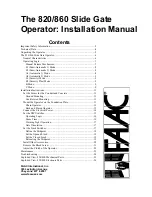
8
E1 (Semi-Automatic 1) Mode
The E1 (semi-automatic 1) mode of operation for the
820/860 Operator is designed for users who want to
signal the gate to either open or close. Sending one
signal, either
open
or
A/C
, to the gate causes it to open
and remain open until another signal is sent. Sending a
second signal closes the gate.
The basic logic of E1 mode is enhanced to protect both
people and property if anything interrupts the gate’s
movement. What happens after such an interruption
depends on whether the gate is opening or closing when
the interruption occurs and depends on whether the
interruption is a second signal or an obstacle in the
gate’s path.
When a second signal interrupts the gate’s opening, the
gate stops. The gate does not move until yet another
signal is sent. Then the gate closes. If a signal interrupts
the gate during closing, the gate immediately reopens.
If an operator has the RC function and an obstruction
interrupts the gate’s opening, the gate may stop its
movement (depending on the weight of the obstruction
and the adjustment of the clutch). When you send a
signal after the gate stops and after the obstruction is
removed, the gate closes.
WARNING!
The pressure the gate leaf applies
to the obstruction is determined by the clutch
adjustment. It is the installer's responsibility to
make sure the clutch is correctly set.
WARNING
! An 860 without RC continues to
open against an obstacle. You must install
reversing devices to protect any potential
obstacle against the momentum and weight of
the gate during opening.
If an operator has the RC function and an obstacle
interrupts the gate’s closing, the gate stops its
movement and automatically re-opens. Sending another
signal causes the gate to close.
WARNING
! An 860 without RC continues to
close against an obstacle. You must install
reversing devices to protect any potential
obstacle against the momentum and weight of
the gate during closing.
Installing external reversing devices alters the logic of
Ε1
mode operation in the following way: During the
opening cycle, any triggered reversing device is
ignored, that is, the gate continues its opening
movement. During closing, a triggered reversing device
causes the gate to fully re-open. Another signal is then
necessary to close the gate.
E2 (Semi-Automatic 2) Mode
The E2 (semi-automatic 2) mode of operation is like E1
except in the way the gate leaf responds while closing
with reversing devices installed.
In E2 mode, a triggered reversing device while the leaf
is closing causes the leaf to stop. It remains stopped
until the reversing device is no longer triggered, and
then the leaf opens.
A1 (Automatic 1) Mode
The A1 (automatic 1) mode of operation for the
820/860 Operator is designed for users who want to
signal the gate once to open (with an
A/C
or
open
command) and then automatically close after a selected
time.
What happens when A1 mode operation is interrupted
depends on which part of the cycle is interrupted by an
activating signal or obstruction. During the opening
phase, a second signal is ignored; the gate continues its
opening travel. During the pause phase, a signal resets
the pause count to 3 or 5 seconds, depending on the
warning light logic. During the closing phase, a signal
to the gate causes the gate to reopen immediately.
If an obstacle interrupts A1 mode operation during
opening on an operator with the RC function, the gate
stops its movement. When it receives another signal
after the obstacle is removed, the gate then will continue
to open.
WARNING
! An 860 without RC continues to
open against an obstacle. You must install
reversing devices to protect any potential
obstacle against the momentum and weight of
the gate during opening.
If during closing an obstacle interrupts A1 mode
operation on an operator with the RC function, the gate
stops its movement and automatically re-opens. Sending
another signal to the gate causes it to complete another
open-pause-close cycle.
WARNING
! An 860 without RC continues to
close against an obstacle. You must install
reversing devices to protect any potential
obstacle against the momentum and weight of
the gate during closing.









































